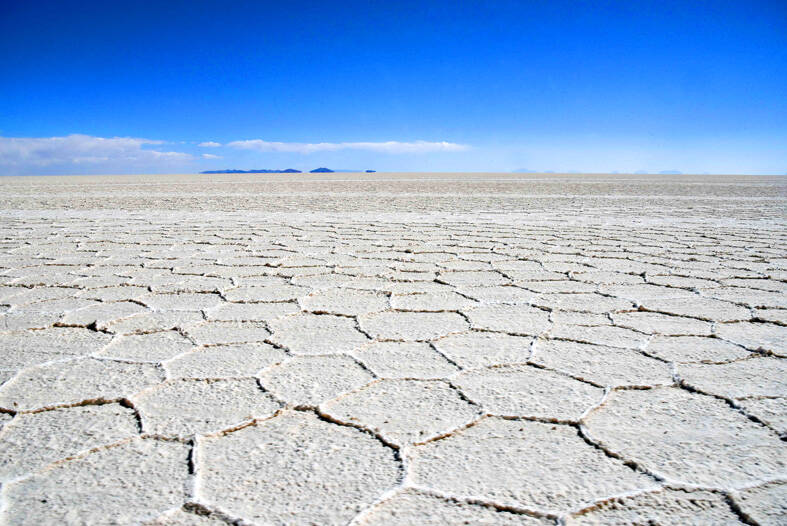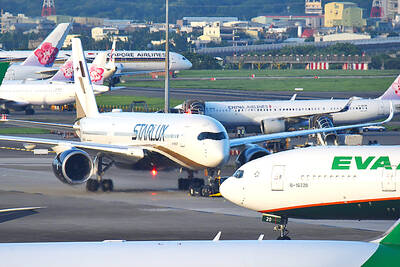In a patch of South America rich in lithium, used to make batteries for electric cars and other tech, Bolivia is lagging its neighbors in the race to mine the key metal.
An area called the “lithium triangle” which spills over the borders of Bolivia, Chile and Argentina is home to 60 percent of the world’s lithium reserves, according to the US Geological Survey.
Bolivia claims to have Earth’s largest deposit of the metal, used to make rechargeable batteries for smartphones, laptops and other devices besides e-vehicles.

Photo: AFP
However, Bolivia has undertaken only four pilot projects and is running just one plant to produce the metal — and at 20 percent of its capacity.
“The next step was going to be taking this up to an industrial level. And this has not been achieved so far,” Bolivian Center for Documentation and Information researcher Gonzalo Mondaca said.
Last year, Bolivia produced 948 tonnes of lithium carbonate, a white salt that is a precursor to the compounds used in lithium-ion batteries, according to the Bolivian Ministry of Mining and Metallurgy.
Based on US estimates, that is one-10th of what Argentina extracted from the earth and just two percent of the haul in Chile, the world’s largest producer after Australia.
“The term lithium triangle is confusing, because it suggests that the area is homogenous,” said Martin Obaya, a researcher at San Martin National University in Argentina. “But it varies from one country to the next and one region to the next.”
In South America, lithium lies in salt flats. The cheapest way to extract it is to pump water up from underground deposits and let it sit in pools to evaporate, leaving the lithium carbonate from which the metal is derived.
In Chile, where the lithium is found in the Atacama Desert, engineers can dig down dozens of meters into the salt flats.
However, this is not possible at Bolivia’s Uyuni salt flat, the world’s biggest, which lies at an altitude of 3,600m.
There, crews can bore down only about 11m, as below that the soil is too compact and it is impossible to pump water up to the surface, Mondaca said.
In December last year, the Bolivian government opened a plant that was supposed to yield 15,000 tonnes per year of lithium carbonate using the evaporation technique. However, the plant did not work properly, and it is now operating at only 20 percent capacity.
“There will always be debate over whether we are facing a window of opportunity that is about to close. It is hard to say, but the project’s performance is frustrating, given the expectations,” Obaya said.
Over the past few months Bolivia raised hopes by signing two contracts for the construction of plants using electro-chemical processes to extract lithium.
This method requires less water but a larger investment up front.
The state lithium company YLB said that with the new technique, producing 1 tonne of lithium at the Uyuni facility would cost US$4,000 to US$8,000, compared with US$2,500 to US$4,000 in Chile.
This year Bolivia signed a deal with a Russian company named Uranium One to build a plant designed to extract 14,000 tonnes of lithium per year.
It also signed a contract with a subsidiary of the Chinese company CATL — the world’s largest battery manufacturer — to set up two lithium extraction sites with a joint capacity of 35,000 tonnes a year.
Both contracts require approval from the Bolivian congress, where the ruling party’s majority is divided between supporters of President Luis Arce and those who back former president Evo Morales. These former allies are now sworn enemies.
Mondaca said Bolivia is simply not prepared for this big lithium challenge “at the technical, legal and institutional level.”
Twenty or 30 years from now Bolivia would be able to produce a lot of lithium, said Gustavo Lagos, a professor at Catholic University in Chile.
But it needs cheaper technology and “we are not there yet,” he added.
The government said Bolivia has the world’s largest lithium resources, but has never stated how much of it can be extracted.
“If the government of Bolivia has succeeded in anything it was in propaganda. It has kept people’s hopes up for more than 15 years,” Mondaca said.

RECYCLE: Taiwan would aid manufacturers in refining rare earths from discarded appliances, which would fit the nation’s circular economy goals, minister Kung said Taiwan would work with the US and Japan on a proposed cooperation initiative in response to Beijing’s newly announced rare earth export curbs, Minister of Economic Affairs Kung Ming-hsin (龔明鑫) said yesterday. China last week announced new restrictions requiring companies to obtain export licenses if their products contain more than 0.1 percent of Chinese-origin rare earths by value. US Secretary of the Treasury Scott Bessent on Wednesday responded by saying that Beijing was “unreliable” in its rare earths exports, adding that the US would “neither be commanded, nor controlled” by China, several media outlets reported. Japanese Minister of Finance Katsunobu Kato yesterday also

China Airlines Ltd (CAL, 中華航空) said it expects peak season effects in the fourth quarter to continue to boost demand for passenger flights and cargo services, after reporting its second-highest-ever September sales on Monday. The carrier said it posted NT$15.88 billion (US$517 million) in consolidated sales last month, trailing only September last year’s NT$16.01 billion. Last month, CAL generated NT$8.77 billion from its passenger flights and NT$5.37 billion from cargo services, it said. In the first nine months of this year, the carrier posted NT$154.93 billion in cumulative sales, up 2.62 percent from a year earlier, marking the second-highest level for the January-September

‘DRAMATIC AND POSITIVE’: AI growth would be better than it previously forecast and would stay robust even if the Chinese market became inaccessible for customers, it said Taiwan Semiconductor Manufacturing Co (TSMC, 台積電) yesterday raised its full-year revenue growth outlook after posting record profit for last quarter, despite growing market concern about an artificial intelligence (AI) bubble. The company said it expects revenue to expand about 35 percent year-on-year, driven mainly by faster-than-expected demand for leading-edge chips for AI applications. The world’s biggest contract chipmaker in July projected that revenue this year would expand about 30 percent in US dollar terms. The company also slightly hiked its capital expenditure for this year to US$40 billion to US$42 billion, compared with US$38 billion to US$42 billion it set previously. “AI demand actually

Jensen Huang (黃仁勳), founder and CEO of US-based artificial intelligence chip designer Nvidia Corp and Taiwan Semiconductor Manufacturing Co (TSMC, 台積電) on Friday celebrated the first Nvidia Blackwell wafer produced on US soil. Huang visited TSMC’s advanced wafer fab in the US state of Arizona and joined the Taiwanese chipmaker’s executives to witness the efforts to “build the infrastructure that powers the world’s AI factories, right here in America,” Nvidia said in a statement. At the event, Huang joined Y.L. Wang (王英郎), vice president of operations at TSMC, in signing their names on the Blackwell wafer to